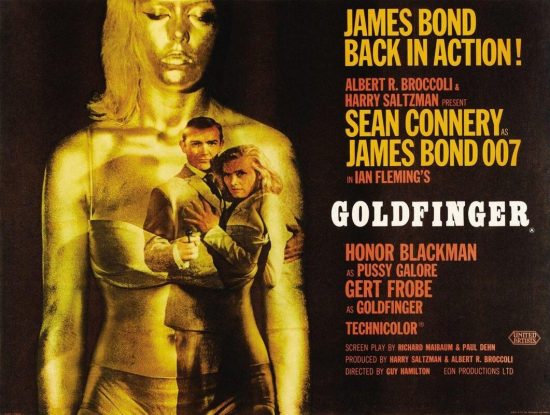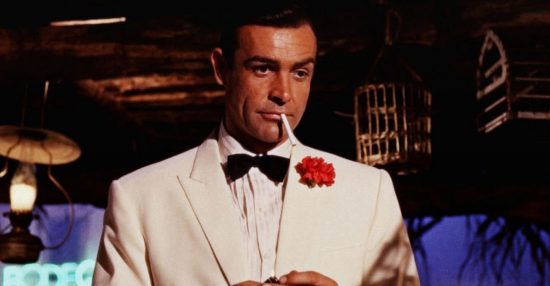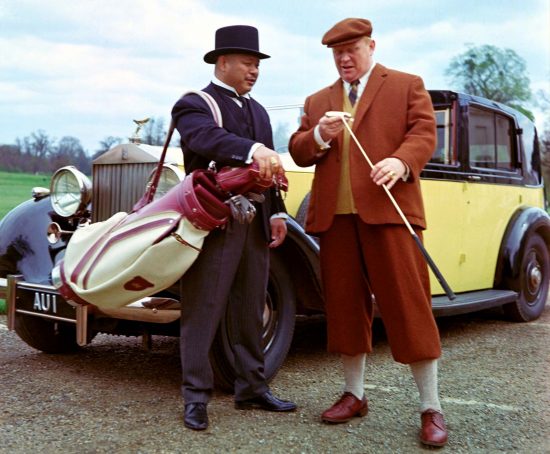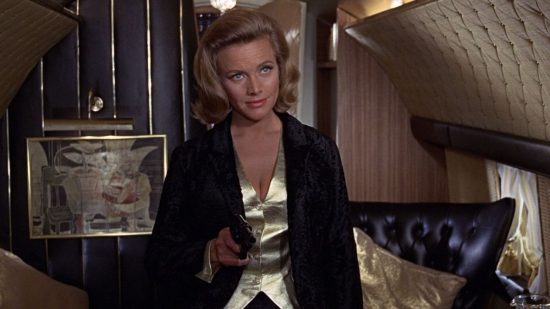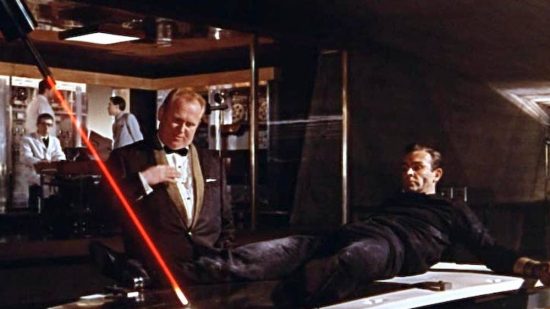Bond Blog: Goldfinger – A James Bond Retrospective
Goldfinger is the quintessential James Bond movie. Dr No and From Russia with Love were feeling their way into a new genre, but the third Connery film has a confidence in its tone, its action, its design and its lead performance that would become the gold standard by which all other Bonds would be judged.
It’s also the first Roger Moore Bond. The argument has always been that Moore introduced an element of camp and self-parody to what were semi-serious spy adventures with a cruel streak that Connery provided. But no one can see Bond arrive at the heroin smugglers’ warehouse, swimming with a duck on his head – only to then strip off his wet suit and reveal a pristine tuxedo – and think that we are in a real-world espionage movie. Gone is the narky cold-hearted killer of Dr. No and welcome a joyful, carefree Connery who throughout the film gives some barely perceptible glances and eye-rolls to the camera. Q had provided nothing more exciting than a briefcase in From Russia with Love, here Desmond Llewellyn gifts Bond with a car that comes with machine guns and an ejector seat. ‘Ejector seat? You must be joking,’ Connery purrs and the franchise begins a long tradition of winking at its own ludicrousness, daring us as to how far we can go and still take any of this seriously. Connery escapes from his cell by winking and pulling faces at his guard in a way that can only be described as goofy. When the bomb timer stops at ‘007’, it’s almost exhilaratingly silly.
Guy Hamilton came in to replace Terrence Young as director and would go on to make a further three Bond films. Hamilton knew Ian Fleming from secret work they did during the war and so had some experience of that world. But his real innovation was to provide Bond with a more compelling adversary. Goldfinger, played by Gert Frobe, is a magnificent presence, both petty and amusing, and also voiced by Michael Collins. Although the potential of Orson Welles playing the role is one of the greatest ‘what ifs’ of the franchise. Odd Job was played wordlessly by Korean weightlifter Harold Sakata and combined menace and a signature killer move – his bladed bowler hat – which again became a template for villains to come. The story is one of a gold merchant – Auric Goldfinger – who plans to irradiate the gold supply in Fort Knox with an atomic device and in so doing force up the value of gold, making his own supply worth that much more. It’s actually an ingenious plot and significantly different from the novel in which Fleming had pitched it as a simple if implausible, robbery. The story allows for some globetrotting as well, from Miami to England, Switzerland to Kentucky, though much of the film was shot at Pinewood with limited location work. In fact, once more the production is spoiled by some truly appalling back projection which blends poorly with the real footage. This was partly due to Connery filming Marnie with Alfred Hitchcock and not being available for the location. But considering the big-budget – more than the first two films combined – there are still moments when speeded up film is used to hide various mistakes and clunks. Bond has always been a mix of high-end filmmaking and a shoddy that’ll-do-ness.
In Honor Blackman and Shirley Eaton are both suitable Bond girls with the latter being a poster girl and in some ways a symbol for how beautiful women are literally objectified by the series. Something I haven’t broached is the reactionary nature of Bond but perhaps this post is a good opportunity. Bond is a reaction to the loss of Empire and the subsequent loss of status in the world. It plays out a fantasy in which Great Britain still has an essential role to play on the world stage but this has to be done in secret lest the Americans and Russians get upset. It is 007 who saves the world while Felix Leiter and his CIA bungle about providing support and little else. Goldfinger plays to these national dreams but it is also squarely aimed at the US market, with gangsters and gambling part of the attraction. 007 provides for the US an injection of cool Britannia – his incongruous remark about listening to the Beatles without earmuffs, while glibly disparaging another British born phenomenon, underlines the way Britain in the 60s is punching well above its weight. This Imperial British identity is also a male white heterosexual and able-bodied identity which defines itself against a rogue gallery of the other who must either be assimilated or completely destroyed. Whether it’s the Japanese ‘half breed’ with the false hands, or the lesbian Rosa Klebb and Pussy Galore, others are there to be converted or destroyed. And yet at least the villainous are visible and although the easy sexism and racism are sometimes difficult to stomach, there is also the sense that the worldly international spy is mixing with a bunch of people, unsurprised and unshocked, who would provoke more than raised eyebrows in the conservative shires. Bond also speaks for a newfound hedonism which is as fascinated by the sexual margins as it is appalled. So yes, Pussy Galore’s lesbianism – which is clear and explicit in the book – is much more coded, and there’s more than a little bit of the rapey when it comes to Bond’s seduction technique but this is also an age finding itself sexually, pulled back by its hang-ups even as it surges forwards into fields of experience that have previously been delivered under brown paper covers.
Overall, Goldfinger establishes the Bond franchise as essentially comedies with strong action elements. Like pantomimes, there’s the need for a strong villain, a sexy girl or two – frequently boyish – lots of jokes and a brassy song – Shirley Bassey blowing her lungs out in the first Bond song to establish the genre. The jokes, by the way, are funny peculiar. Most frequently they’re homicidal quips delivered with all the groaning pleasure of the original dad joke. Ken Adams returns to the franchise and makes his stylish mark on the series in a way which is going to become increasingly recognisable as it goes on. And as the titles now promises with more confidence – following a protracted legal case the consequences of which will rumble on – Bond will return in Thunderball.

